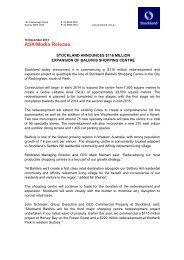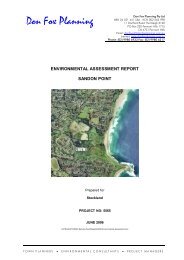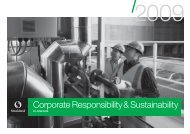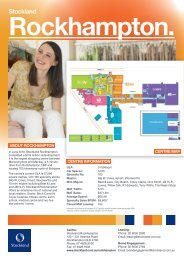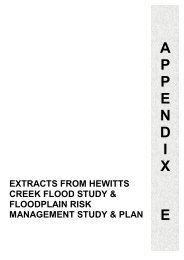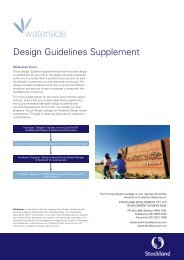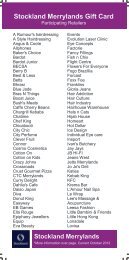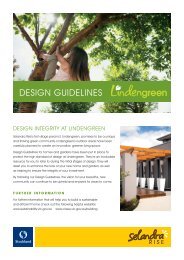Download PDF - Stockland
Download PDF - Stockland
Download PDF - Stockland
Create successful ePaper yourself
Turn your PDF publications into a flip-book with our unique Google optimized e-Paper software.
CR&S 2010<br />
Our<br />
marketplace<br />
Affordable products<br />
and services<br />
Affordability extends beyond our<br />
Residential business as we aim to provide<br />
good quality space and good value<br />
services to our tenants throughout our<br />
retail, office and industrial assets.<br />
For many years we have worked with<br />
a variety of external agents, such as<br />
marketing experts, financial planners<br />
and merchandising specialists, to help<br />
our tenants facing financial difficulties. In<br />
FY11 we will be partnering with a training<br />
provider to deliver voluntary training to<br />
retail tenants on financial management.<br />
We also provide low cost or free casual<br />
leasing space to not-for-profit and<br />
community groups in our retail centres.<br />
This has been extended to occasional<br />
support to tenants such as the not-forprofit<br />
organisation, Sydney Care which,<br />
at no cost, uses office and warehouse<br />
space in our facility at North Ryde, Triniti.<br />
We see this as a tangible way to support<br />
community organisations.<br />
To further extend our support to tenants<br />
to meet affordability needs, we have<br />
partnered with the New South Wales<br />
Department of Climate Change and<br />
Water to provide retail tenants with energy<br />
efficiency training. This training – delivered<br />
in a dynamic, online format – will help<br />
our tenants reduce their energy bills<br />
and improve environmental efficiencies.<br />
We will report on outcomes in our<br />
CR&S report 2011.<br />
Our suppliers<br />
Engaging our suppliers<br />
As a property owner, manager and<br />
developer, we have a large number of<br />
contractors and suppliers. We recognise<br />
that we can have a significant impact by<br />
engaging with them on sustainability. Our<br />
contractors and suppliers include builders<br />
and civil contractors, as well as security<br />
and cleaning service providers. Despite<br />
our lack of direct control over these<br />
activities, we can influence the decisions<br />
made by our contractors on the selection<br />
of materials and the working conditions<br />
of their employees, by setting clear<br />
expectations. Engaging our suppliers is<br />
a key focus area for us and allows us to:<br />
• Manage shared risks in relation to<br />
green tools and regulatory reporting,<br />
• Discover shared innovation<br />
opportunities,<br />
• Work together to enhance our<br />
relationships with the communities<br />
in which we operate.<br />
In FY10 we began integrating CR&S<br />
requirements, systems and targets<br />
into scope of work documents and<br />
specifications for our suppliers.<br />
We have developed sustainability<br />
guidelines in our business units to<br />
help suppliers better understand<br />
our sustainability goals.<br />
Most suppliers already recognise<br />
that sustainability initiatives and obligations<br />
are part of doing business with us. We are<br />
working with suppliers to support them as<br />
they expand their commitments and face<br />
emerging regulatory requirements and<br />
growing stakeholder expectations.<br />
Sustainability obligations for<br />
our suppliers<br />
Our suppliers’ performance, where<br />
possible, is measured against specified<br />
sustainability obligations. These measures<br />
are generally reviewed monthly or as part<br />
of the project completion review. Examples<br />
of our sustainability obligations are:<br />
Labour – Obligations are embedded in<br />
the general conditions of contract and are<br />
reviewed regularly to ensure compliance.<br />
They cover issues such as wages,<br />
insurance and payment of benefits.<br />
Health and Safety – Obligations reflect<br />
statutory obligations and are embedded<br />
in the general conditions of contract.<br />
Compliance with these obligations is<br />
monitored as part of asset reviews.<br />
Environmental – Obligations reflect<br />
statutory obligations and are embedded<br />
in the general conditions of contract.<br />
Compliance with these obligations is<br />
monitored as part of asset reviews.<br />
Waste – We have set targets for increasing<br />
the amount of waste that is diverted from<br />
landfill to recycling. For our office business<br />
a target of 70 per cent diversion from<br />
landfill forms part of the waste agreement.<br />
Mechanical – Capital expenditure (capex)<br />
projects now specify low emission and<br />
energy-efficient equipment. Where possible<br />
low environmental impact materials are<br />
being used. Testing and balancing new air<br />
conditioning plant and other equipment is<br />
now focused on optimising the building’s<br />
NABERS rating, improving building energy<br />
efficiency and maximising overall plant/<br />
equipment performance.<br />
Lifts – Capex projects specify, where<br />
possible, renewable and environmentallysensitive<br />
material. Systems are also<br />
designed to operate in the most energyefficient<br />
manner.<br />
Security – We are introducing customer<br />
service training for our security suppliers.<br />
This will help increase the skills of security<br />
contractors and will lead to improved<br />
service levels and customer interaction.<br />
The labour, health and safety and<br />
environmental measures are core<br />
requirements for all suppliers. The other<br />
measures listed above are selected after<br />
consideration of the scope of the works<br />
and services to be delivered and the<br />
opportunities available.<br />
We are committed to ensuring that<br />
sustainability remains a consideration<br />
for services and construction contracts,<br />
and to further improving our responsible<br />
supply chain management initiatives. Over<br />
the past year we have continued to survey<br />
our larger suppliers on their corporate<br />
responsibility and sustainability policies,<br />
commitments and performance.<br />
Responsible Supply Chain<br />
Management<br />
Our commitment to responsible supply<br />
chain management is driven by the<br />
following factors:<br />
• Corporate values – aligning<br />
our corporate values with our<br />
procurement practices,<br />
• Legislation – now and emerging,<br />
• Cost reduction – creating<br />
sustainable value,<br />
• Improving efficiencies,<br />
• Market and customer requirements,<br />
• Risk management – including<br />
reputational risk.<br />
52<br />
<strong>Stockland</strong> Corporate Responsibility & Sustainability Report June 2010



